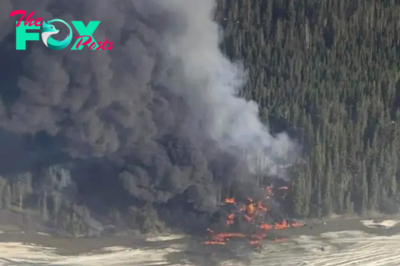US News
Researchers find new way to store carbon dioxide absorbed by plants at the bottom of the Black Sea
Researchers have found a new way to store thousands of years' worth of carbon dioxide and prevent it from being released into the atmosphere, furthering efforts to limit greenhouse gas emissions from several sources.
Carbon sequestration, or carbon capture, typically involves plucking the carbon out of the atmosphere, compressing it and storing it underground.
But Israel-based climate change solutions company Rewind drew inspiration from the natural processes of the earth for an innovative solution on carbon storage, Ram Amar, CEO of Rewind, told ABC News.

The method involves taking plants and other biomass that have absorbed dense amounts of carbon and storing it at the bottom of the Black Sea, Amar said.
"We look to nature, because the best machine capturing carbon dioxide from the air today is plants," Amar said.
MORE: These geoengineering technologies could help combat the climate crisis, scientists say
Plants, especially trees, are known for their ability to capture and pack away carbon dioxide. As the plants photosynthesize, they take carbon dioxide from the air, which allows them to grow. Then, when they die and decompose, they release the carbon back into the air, Amar said.
The researchers hypothesized that if they could preserve the balance of how much carbon is released when the plants die, they could achieve a net-negative effect of carbon reentering the atmosphere, Amar said.
Rewind takes existing plant matter that has been burned or not being put to good use and ship it out to the coast, sinking it to the bottom of the Black Sea.

The Black Sea is "the best place in the world" to store the carbon-dense biomass for several reasons, Amar said. The geological shape of the enclosed sea prevents oxygen from mixing from the top layers, where photosynthesis occurs and where oxygen comes from the air, with the deeper layers.
The lack of oxygen creates the perfect preservation environment for plants, which will prevent them from decomposing and releasing the carbon dioxide back into the atmosphere, experts said.
MORE: Researchers discover another way tropical forests could suffer due to climate change
What initially drew Amar to the Black Sea were several wooden shipwrecks that lie at the bottom of the sea that have been "frozen in time for more than 2,000 years," he said.
"We figured that if we take residual plants and throw them on the bottom of the Black Sea, they will be kept away from the air for thousands of years," he said. "That checks the box of permanence with a natural solution."

In addition, since the Black Sea is surrounded by the Breadbasket of Europe, countries like Ukraine, Bulgaria and Romania that grow hundreds of millions of tons of agriculture per year, there is about a gigaton of residual biomass left every year, when combined with the amount of wood products from both natural and managed forests in the region, Amar said.
Woody plants, such as trees, are the best biomass to be used in this process because they capture carbon quickly and are very stable in water, Amar said. Other agricultural leftovers, such as the stalks of sunflowers harvested for their seeds and oil, also fit the bill for this method of carbon storage, Amar said.
The plants are tested for how much carbon they contain and whether they contain harmful chemicals such as fertilizer and pesticides before they are transported and sunk into the sea, Amar said.
MORE: Greenhouse gas emissions are continuing to increase, making climate mitigation more challenging: UN report
Amar and his team have estimated that, if scaled up, this method of carbon storage could remove 1 billion tonnes of carbon dioxide from the atmosphere per year.
In 2022, the world collectively emitted about 36.6 billion tons of carbon dioxide, according to the Global Carbon Budget. The United Nations' Intergovernmental Panel on Climate Change announced last year that carbon removal is critical to climate change mitigation.
While about 2 billion tonnes of carbon are removed from atmosphere each year by carbon capture, the goal should be 10 billion tonnes of removal per year to meet urgent net-zero goals, according to the IPCC.

While carbon capture has become a viable solution for climate mitigation, one of the biggest challenges is the amount of energy it takes to filter CO2 from the air, along with the cost of infrastructure and operations, according to experts.
In August, the U.S. Department of Energy announced it would award up to $1.2 billion to two projects dedicated to direct air capture, the largest investment in engineered carbon removal ever made.
Last year, the Energy Department pledged $2.6 billion in funding for the Carbon Capture Demonstration Projects Program, which aims to create storage technologies and infrastructure at major industrial sources of carbon dioxide, such as cement, pulp and paper, iron and steel and chemical production facilities.
-

 US News9m ago
US News9m agoGovernor Newsom Wants to Let Arizona Doctors Provide Abortions in California
-

 US News9m ago
US News9m agoAirlines Will Now Have to Give Automatic Cash Refunds for Canceled and Delayed Flights
-

 US News6h ago
US News6h agoTesla Is in Panic Mode. Can Elon Musk Turn the Company Around?
-

 US News6h ago
US News6h agoNo Survivors Found After Plane Crashes in Alaska River
-

 US News13h ago
US News13h ago$95B Aid for Ukraine, Israel and Taiwan Advances in Senate With Big Bipartisan Vote
-

 US News13h ago
US News13h agoSupreme Court Appears Poised to Side With Starbucks in Labor Dispute Over Firing of Pro-Union Employees
-

 US News19h ago
US News19h agoScenes From Pro-Palestinian Encampments Across U.S. Universities
-

 US News19h ago
US News19h agoNew FTC Rule Bans ‘Noncompete’ Agreements for Most Employees



























